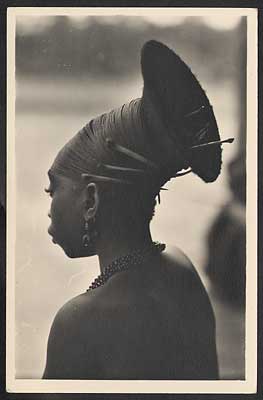
Section Three
Africans and Photography


In 1870, German botanist Georg Schweinfurth was the first European to reach the Mangbetu, who live in northeastern Democratic Republic of the Congo. His exploration account describes them as aristocratic and elegant. Their royal courts, their practice of accentuating the elongation of their heads with elaborate hair styles, their court dances, royal architecture and their arts attracted Western photographers and later film makers in the first half of the 20th century. Profile views of Mangbetu women with the classic coiffure emerged as iconic images and circulated in many media in the West, ranging from postcards, trade cards and postage stamps to sculptures, jewelry, book ends and hood ornaments for cars.
Mangbetu chiefs everywhere accommodated photographers, arranging performances and sitting for them in their full regalia--which included the bright silver chief's medal awarded to them by the government--visually demonstrating their influence and importance both among their subjects and in the colonial state. The chief of Ekibondo even transformed his entire village into an attraction for foreign visitors. Casimir Zagourski and many others took fine images of Mangbetu painted houses and performances in Ekibondo, contributing to the artistic and aristocratic reputation of the Mangbetu
Pictured above
Mangbetu coiffure, Oriental Province, Belgian Congo
Casimir Zagourski (1883-1944)
L'Afrique qui disparaît! Series 1, no. 55
c. 1929-1937, silver gelatin print
Eliot Elisofon Photographic Archives
National Museum of African Art
Smithsonian Institution
1987-241055